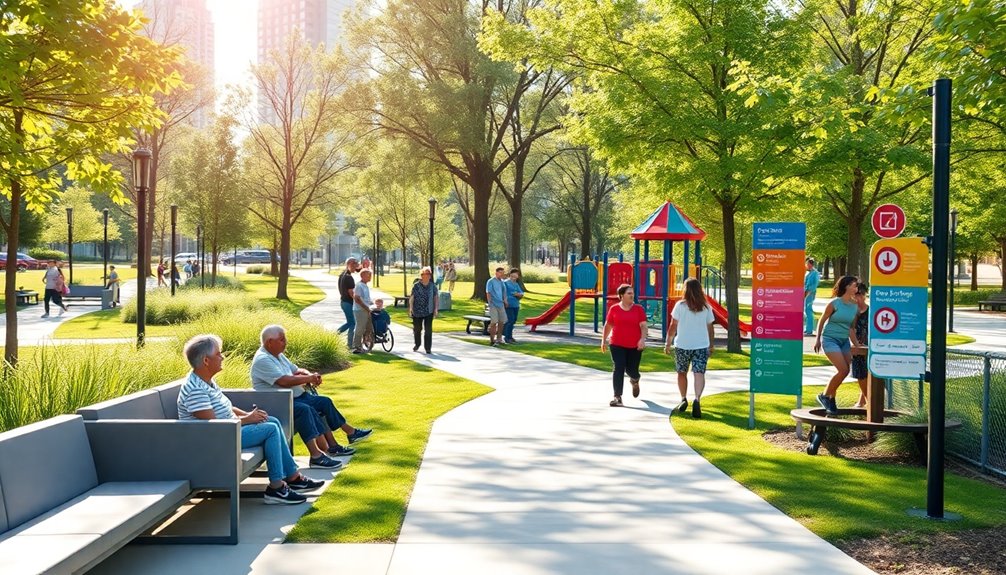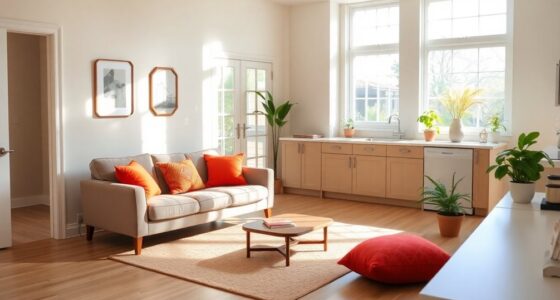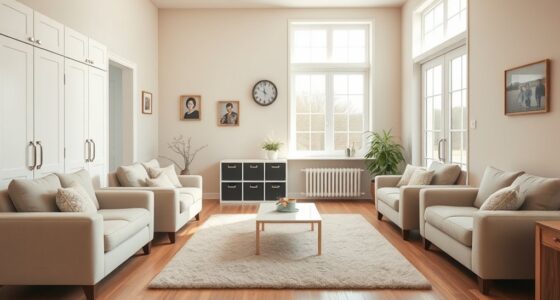You've got to check out these 10 innovative age-friendly design solutions! From smart home technologies that boost safety to modular housing that adapts as your needs change, these features make daily life easier and safer. You'll find sensory-friendly spaces that support cognitive needs and eco-friendly materials that promote sustainability. Plus, walkable communities foster active living and social connections. Keep exploring to discover even more transformational ideas that cater to all ages and abilities!
Key Takeaways
- Smart Home Technologies: Utilize fall detection systems and motion-activated lighting to enhance safety and prevent accidents in elderly living spaces.
- Adaptable Interiors: Implement modular housing with flexible room configurations that can be easily reconfigured to accommodate changing mobility and care needs.
- Community Design: Foster walkable communities with accessible pathways and communal spaces to promote social interaction and active living among seniors.
- Eco-Friendly Materials: Incorporate sustainable building materials and renewable energy sources to create healthier living environments and reduce environmental impact.
- Sensory-Friendly Spaces: Design interiors with high-contrast visuals and clear signage to support individuals with sensory impairments and enhance navigation.
Universal Design Principles for Accessibility

When you think about creating spaces and products that everyone can use, universal design principles come to the forefront. These principles focus on accessibility, ensuring that environments cater to all individuals, regardless of age or ability.
By incorporating features like curb cuts and automatic doors, you make it easier for those with mobility challenges to navigate. High-contrast visuals and large text are also essential for accommodating sensory impairments, enhancing readability for older adults.
Embracing user-centered design (UCD) emphasizes usability and engagement, creating inclusive solutions that benefit families with young children and individuals with disabilities. Additionally, home improvement strategies can significantly enhance the living experience for the elderly.
Ultimately, universal design not only improves the experience for older adults but fosters a more inclusive society for everyone.
Smart Home Technologies for Enhanced Safety

Smart home technologies can greatly enhance your safety at home.
With fall detection systems and motion-activated lighting, you can minimize the risk of accidents in dimly lit areas.
Plus, remote monitoring solutions give you and your family peace of mind, knowing that help is just a notification away. Additionally, the presence of security systems can deter potential intruders, contributing to an overall safer environment.
Fall Detection Systems
As you age, maintaining safety at home becomes increasingly important, and fall detection systems offer an essential solution.
These smart technologies utilize advanced sensors and algorithms to monitor your movement patterns, automatically alerting caregivers or emergency services if a fall occurs. Many systems incorporate smart flooring that detects falls and notifies designated contacts, ensuring rapid responses that can reduce the risk of serious injuries.
They can also differentiate between ordinary movements and actual falls, minimizing false alerts. Wearable devices with fall detection capabilities often include health monitoring features like heart rate and activity tracking, contributing to your overall health and wellness.
With these systems in place, you can enjoy greater peace of mind in your home.
Motion-Activated Lighting
Enhancing safety at home is essential for older adults, and motion-activated lighting systems provide an effective solution.
These smart technologies automatically light up spaces when you move, greatly reducing the risk of falls during nighttime navigation.
Here's how they enhance accessibility and comfort:
- Automatic Illumination: Lights activate when you enter a room, ensuring you're never left in the dark. Additionally, incorporating energy-efficient systems can further reduce energy costs while improving safety.
- Remote Control: Caregivers can monitor and adjust lighting for added safety.
- Cost-Effective: Installation is affordable and improves overall home safety.
- Independence: Seniors can navigate their homes confidently, boosting their sense of security.
Moreover, integrating smart utilities for home can further enhance energy efficiency and comfort in living spaces.
Remote Monitoring Solutions
While maneuvering through the complexities of aging, remote monitoring solutions offer a lifeline for older adults and their caregivers.
These smart home technologies use sensors and cameras to provide real-time updates on the safety and well-being of aging individuals. You can set up automated lighting that activates with motion, reducing the risk of falls during nighttime navigation. Additionally, having advance directives in place can complement these technologies by guiding medical decisions in emergencies.
Many solutions integrate with mobile apps, allowing you to access health data and monitor daily activities, fostering peace of mind. Plus, the fall detection systems alert caregivers immediately when a fall occurs, improving response times.
Enhanced security features like smart locks and doorbell cameras also help aging individuals feel safer at home while allowing family members to monitor access remotely. Additionally, home security system costs can vary significantly based on the type of system and features selected, making it essential to choose a solution that fits both safety needs and budget.
Modular Housing Solutions for Flexibility

- Adaptable Layouts: Easily reconfigure spaces to fit your mobility and care needs without costly renovations.
- Cost Efficiency: Reduced construction time and costs make age-friendly housing accessible to low-income populations.
- Smart Technology: Incorporate health monitoring systems for enhanced safety, like fall detection and remote health checks.
- Sustainable Living: Modular solutions allow for vertical expansion, maintaining social spaces for community engagement among older adults.
Additionally, integrating budget-friendly maintenance plans can ensure that these modular homes remain in optimal condition, further enhancing the quality of life as you age.
Embracing these modular housing options can considerably improve your quality of life as you age.
Sensory-Friendly Spaces for Cognitive Support
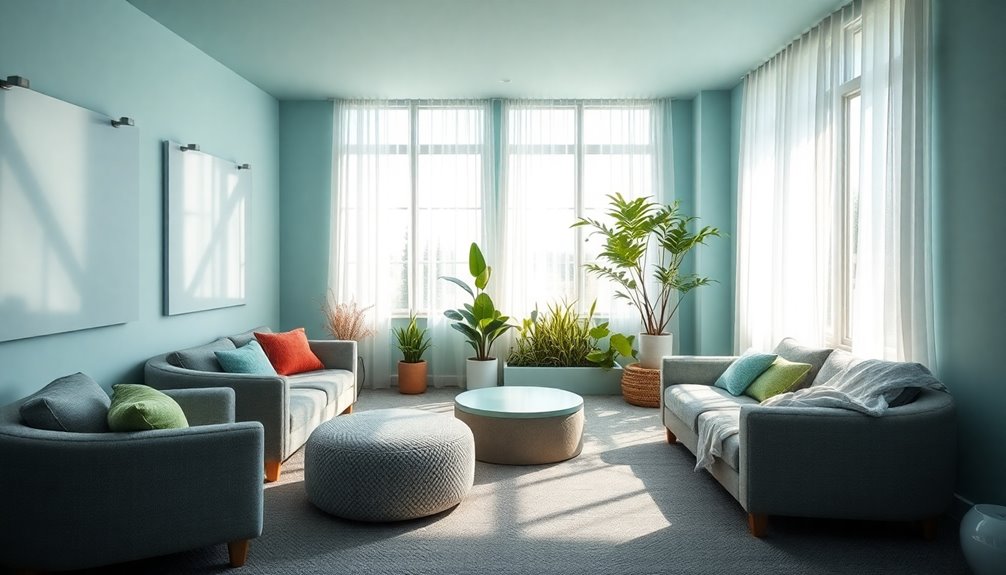
Creating sensory-friendly spaces is essential for supporting the cognitive needs of older adults, as these environments can greatly enhance their quality of life.
By incorporating inclusive design, you can address common sensory impairments, like reduced vision and hearing loss, through high-contrast visuals and sound insulation. Features such as clear signage and intuitive layouts help with navigation, aiding memory retention. Additionally, incorporating elements like Alzheimer bracelets can provide reassurance for caregivers by ensuring immediate identification in case of emergencies. Using essential oil safety practices can also contribute to creating a calming atmosphere in these spaces.
Research shows that reducing background noise and improving acoustics considerably enhances communication comfort, fostering social interactions. Additionally, using natural light and calming colors promotes mental well-being and reduces anxiety.
Integrating smart technology, like interactive displays and adaptive lighting, further supports cognitive engagement, creating a holistic environment that enriches the experiences of elderly individuals. Furthermore, utilizing efficient energy use in these spaces can help lower overall energy costs, enhancing comfort and sustainability.
Walkable Communities Promoting Active Living

In walkable communities, you'll find accessible pathways and trails that encourage you to stay active.
Community gathering spaces foster connections with neighbors, while convenient transportation options enhance your mobility.
Together, these features create an environment that promotes not just physical health but also social well-being.
Accessible Pathways and Trails
Accessible pathways and trails play an essential role in fostering active living within walkable communities, especially for seniors.
These thoughtfully designed routes not only accommodate mobility devices but also enhance the overall quality of life for older adults.
By incorporating key features, communities can greatly improve usability and promote engagement.
Here are four essential elements to take into account:
- Smooth, even surfaces for easy navigation.
- Resting areas to encourage longer outings.
- Clear signage for better orientation and safety.
- Safe crossings to facilitate seamless changes.
These accessible pathways encourage physical activity, reduce isolation, and boost mental well-being, making communities healthier and more vibrant for everyone.
Embracing such designs guarantees that older adults can actively participate in their neighborhoods.
Community Gathering Spaces
While community gathering spaces may seem like simple amenities, they play an important role in promoting active living and social interaction in walkable neighborhoods.
These thoughtfully designed areas encourage residents to come together, fostering relationships that enhance overall well-being. By prioritizing accessibility and inclusivity, community gathering spaces feature wide pathways and seating that cater to individuals of all ages and abilities. Additionally, such environments can support emotional regulation, helping individuals manage their stress and improve their social interactions. According to research, emotional instability can be alleviated in supportive environments, emphasizing the need for community support networks.
Research shows that neighborhoods with such spaces have a 20% higher rate of physical activity, contributing to better health outcomes. Additionally, these spots create opportunities for intergenerational connections, allowing older adults to engage with younger community members.
Incorporating green spaces and recreational facilities reduces feelings of isolation, making inclusive communities crucial for mental health and social support networks. Moreover, the presence of end-of-life care options can provide peace of mind for families, enhancing the overall sense of community support.
Transportation Options and Connectivity
Transportation options and connectivity are essential for fostering active living in walkable communities, especially for older adults.
When neighborhoods embrace age-friendly design, they create environments that enhance mobility and encourage independence.
Here are some key features to look for:
- Accessible Public Transport: Low-floor buses and trains make it easier for seniors to get around.
- Pedestrian-Friendly Features: Well-maintained sidewalks and crosswalks increase walking rates by up to 50%.
- Mixed-Use Developments: Living close to shops and parks promotes social interaction and reduces isolation.
- Safety Measures: Thoughtful urban planning decreases the risk of falls and injuries.
Communal Areas for Social Interaction

Creating communal areas for social interaction can dramatically improve the lives of older adults by fostering connections and combating loneliness.
By applying thoughtful design principles, you can create spaces that enhance social connectivity. Open seating arrangements and multipurpose rooms encourage residents to engage with one another, cultivating a strong sense of community. Additionally, incorporating elements of water parks can provide opportunities for recreational activities that are both enjoyable and accessible. These features align with the goal of transforming spaces to better cater to the needs of seniors.
Features like gardens, art studios, and recreational areas not only promote physical activity but also support mental well-being through creative expression and outdoor engagement. Additionally, incorporating elements of pet therapy can further enhance emotional well-being and reduce feelings of isolation among residents.
Prioritizing accessibility is essential; wide pathways and seating that accommodates mobility aids guarantee everyone can participate comfortably.
Research shows that well-designed communal areas lead to higher satisfaction and overall well-being among older adults, underscoring the importance of intentional architectural planning.
Adaptable Interiors for Changing Needs

When designing your home, think about how flexible room configurations and convertible furniture can adapt to your changing needs.
Future-proofing your space with elements like adjustable fixtures guarantees you can easily modify your environment as your mobility and lifestyle evolve.
Flexible Room Configurations
Flexible room configurations are essential in age-friendly design because they allow spaces to adapt to your evolving needs as you age. By incorporating these adaptable interiors, you can enhance your independence while aging in place.
Here are some key benefits:
- Modular furniture lets you easily rearrange spaces for different activities, whether it's hosting friends or managing personal care.
- Movable partitions create private areas without major renovations, saving you time and money.
- Open floor plans promote unobstructed movement, making it easier for mobility aid users.
- Smart technologies, like adjustable lighting, cater to the user preferences of older adults, ensuring comfort and well-being.
With flexible room configurations, your home can grow with you, providing a supportive environment for all stages of life.
Convertible Furniture Solutions
As your needs evolve, convertible furniture solutions can greatly enhance your living space by offering versatility and practicality.
For older adults, options like sofa beds and extendable dining tables maximize space while accommodating changing mobility and lifestyle needs.
Adjustable height desks and tables promote comfort, allowing you to switch between seated and standing use, which encourages active living.
Modular furniture pieces can be rearranged to create different layouts, fostering adaptability and enhancing social interactions.
Multi-functional storage solutions, such as ottomans with hidden compartments, keep essential items accessible and organized.
Additionally, smart furniture designs with built-in charging ports and app-controlled features enhance usability, simplifying everyday tasks and making your living environment more convenient and enjoyable.
Future-Proofing Design Elements
To guarantee your home meets your needs as you age, investing in future-proofing design elements can make a significant difference.
Consider these key aspects:
- Adaptable Lighting: Install dimmers and adjustable fixtures to accommodate various preferences and physical capabilities.
- Smart Home Technologies: Integrate systems that allow for real-time monitoring and assistance, enhancing safety and security.
- Convertible Spaces: Design areas that can be easily reconfigured, promoting independence and flexibility in your living space.
- Accessibility Features: Plan for wider doorways and install grab bars early on to reduce the need for costly renovations later.
Non-Slip Flooring and Fall Prevention Features
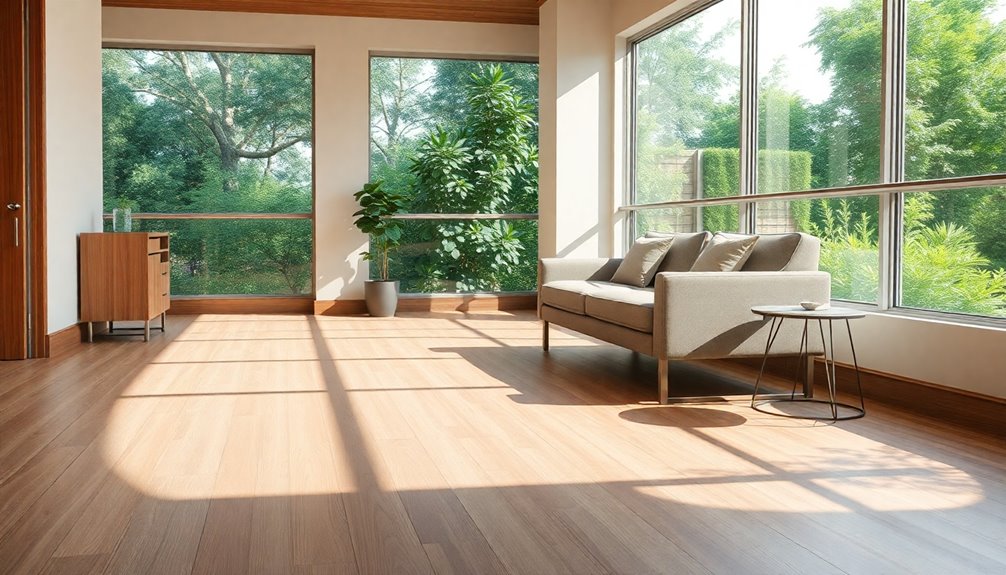
Ensuring safety at home is essential, especially for older adults, and non-slip flooring plays an important role in fall prevention. With one in four seniors experiencing a fall each year, choosing the right flooring is vital.
Textured surfaces and materials with high friction coefficients provide better grip, particularly in high-risk areas like bathrooms and kitchens. Walk-in showers with non-slip flooring further enhance safety, often including grab bars and mats to prevent accidents.
Innovative smart flooring systems that detect falls and alert caregivers are also emerging, adding an extra layer of security for seniors living independently.
Don't forget, regular maintenance is key—worn-out flooring can compromise safety, so opt for durable materials that maintain their non-slip properties over time.
Inclusive Design for LGBTQ+/SGL Older Adults
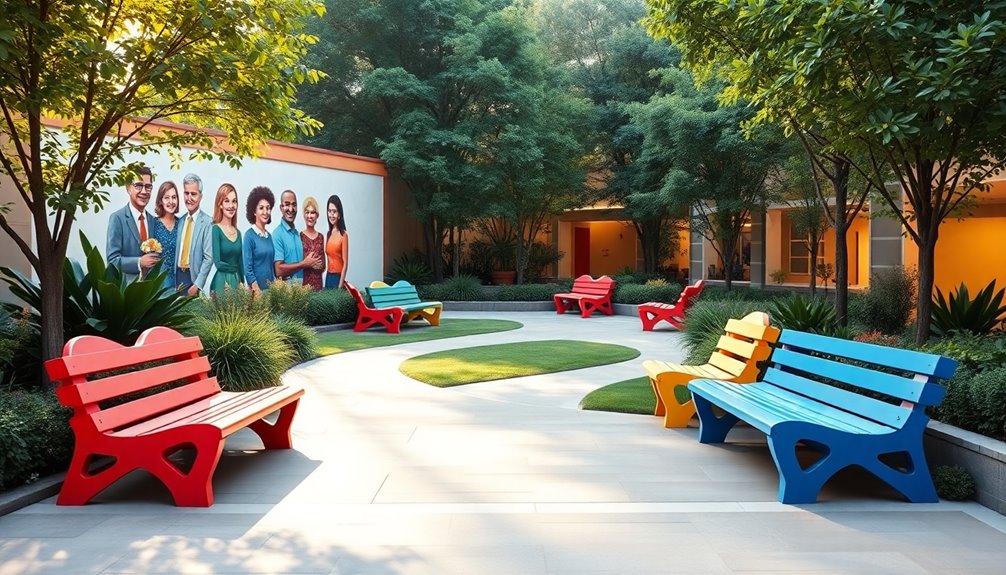
Creating an inclusive environment for LGBTQ+/SGL older adults is essential for fostering a sense of safety and belonging. By implementing inclusive design, you can help address the unique challenges faced by this population, enhancing their mental and physical well-being.
Here are four key strategies to reflect on:
- Gender-neutral bathrooms guarantee everyone feels comfortable.
- Community spaces that celebrate diversity promote connection and reduce isolation.
- Staff training on LGBTQ+ cultural competency cultivates a welcoming atmosphere.
- Specialized housing initiatives, like the LGBTQ+ Elder Housing Initiative, focus on affordable options tailored to seniors' needs.
These strategies not only improve health outcomes but also contribute to a resilient and inclusive community for older adults.
Eco-Friendly Materials and Sustainable Practices

While many age-friendly designs prioritize comfort and accessibility, incorporating eco-friendly materials and sustainable practices is equally essential for enhancing the well-being of older adults.
Using materials like bamboo, reclaimed wood, and recycled metal not only reduces environmental impact but also adds durability and aesthetic appeal.
When you choose sustainable practices in construction, such as non-toxic paints and low-VOC materials, you greatly improve indoor air quality, benefiting health.
Adding renewable energy sources like solar panels can lower utility costs, promoting financial sustainability.
Also, consider green roofs and living walls for better insulation and soothing environments.
Finally, designing outdoor spaces with permeable paving and native plant landscaping supports stormwater management while encouraging physical activity in accessible areas for seniors.
Frequently Asked Questions
How to Design for Elderly People?
When you design for elderly people, focus on accessibility and safety. Incorporate wide doorways and clear pathways for easy movement.
Use high-contrast colors and large text for readability. Ascertain non-slip flooring and strategically placed grab bars in high-risk areas, like bathrooms.
Make storage units adjustable and within reach to prevent strain.
Finally, integrate smart home technologies to enhance safety and independence, allowing seniors to maintain a higher quality of life while aging in place.
What Are Some Strategies to Assist Older Adults?
To assist older adults, you can start by implementing user-centered design principles that focus on their needs and limitations.
Incorporate smart home technologies for enhanced safety, like motion-activated lighting.
Create walkable communities with accessible public transportation to encourage active living.
Use high-contrast visuals and large text for better readability in technology.
Finally, design adaptable living spaces so older adults can age in place comfortably, reducing the need for costly relocations.
What Is Inclusive Design for Older Adults?
Inclusive design for older adults focuses on creating environments that cater to diverse abilities.
You'll notice features like high-contrast visuals and large text that make navigation easier. User-friendly controls help address common challenges like vision and dexterity issues.
How to Design for Elderly UX?
Did you know that 37 million Americans over 50 face vision impairments?
When designing for elderly users, you should prioritize high-contrast visuals and large text sizes, at least 16px.
Use simple interactions with larger buttons to enhance accessibility.
Introduce information gradually and use self-explanatory labels to aid memory.
Simplify security measures to build trust, and provide clear feedback mechanisms to let older adults navigate technology comfortably and at their own pace.
Conclusion
In a world where age often feels like a barrier, these innovative design solutions are your key to revealing a more vibrant, fulfilling life. Just like a well-crafted novel, each element tells a story of inclusivity, safety, and adaptability. Embrace these ideas, and you’ll find that age is merely a chapter, not the final page. So, step into a future where every space is designed for you—because living well at any age is a story worth telling. These agefriendly design tips encourage us to rethink our environments, making them not just functional but also enjoyable for individuals of all ages. From flexible seating arrangements to intuitive layouts that promote movement, every adjustment contributes to a narrative of empowerment and connection. Let these thoughtful changes inspire you to create spaces that celebrate life at every stage, allowing creativity and community to flourish.
